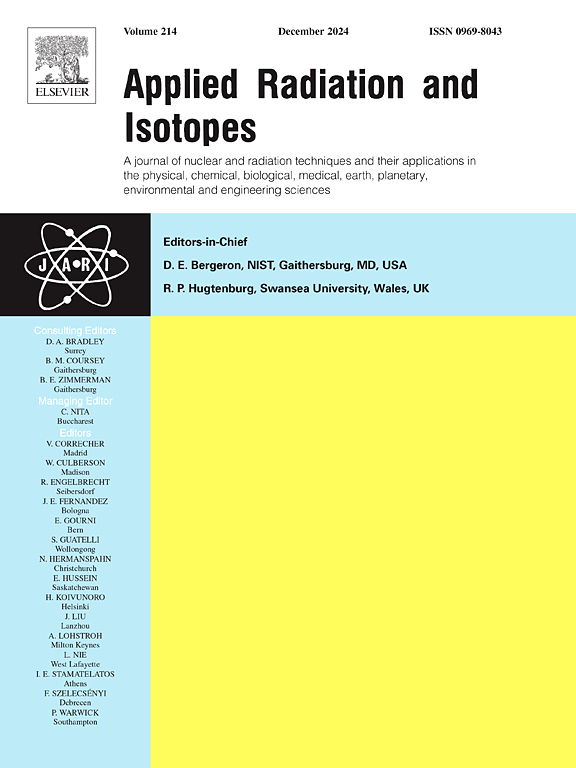用于医学成像系统的人工智能增强x射线光谱重建。
IF 1.6
3区 工程技术
Q3 CHEMISTRY, INORGANIC & NUCLEAR
引用次数: 0
摘要
为了在放射学、计算机断层扫描(CT)、透视、乳房x线摄影等领域评估图像质量和计算患者x射线剂量,有必要事先了解x射线能谱。x射线管的主要组成部分是电子灯丝(也称为阴极)和阳极(阳极通常由钨或铷制成,并呈一定角度)。在阴极和阳极产生的电子接触的地方,产生了一个能量从零到释放电子的最大能量值的x射线光谱。通常,x射线的能量分布取决于各种参数,包括电子束的能量(电子管电压)和阳极的角度。因此,x射线能谱是特定于每个管和成像系统的配置。本研究旨在开发一种有效的方法,使用有限的特定光谱,在广泛的管电压和阳极角度范围内快速确定医学成像系统的x射线能谱。研究首先使用蒙特卡罗N粒子(MCNP)方法模拟了12°至24°之间七种不同的阳极角度。生成了20、30、40、50、60、70、80、100、130和150 kV管电压下的x射线光谱。为了进行逐点x射线光谱预测,以管电压和阳极角度作为输入,训练了150个径向基函数神经网络(RBFNNs)。对RBFNNs进行了训练,以预测不同靶角和管电压在20 ~ 150 kV之间的x射线光谱。本研究仅使用蒙特卡罗模拟来代表一个系统;然而,这里展示的方法可以推广到任何现实世界的系统。本文章由计算机程序翻译,如有差异,请以英文原文为准。
AI-enhanced X-ray spectrum reconstruction for medical imaging system
For the purpose of assessing image quality and calculating patient X-ray dosage in radiology, computed tomography (CT), fluoroscopy, mammography, and other fields, it is necessary to have prior knowledge of the X-ray energy spectrum. The main components of an X-ray tube are an electron filament, also known as the cathode, and an anode, which is often made of tungsten or rubidium and angled at a certain angle. At the point where the electrons generated by the cathode and the anode make contact, a spectrum of X-rays with energies spanning from zero to the maximum energy value of the released electrons is created. Typically, the energy distribution of X-rays depends on various parameters, including the energy of the electron beam (tube voltage) and the angle of the anode. As a result, the X-ray energy spectrum is specific to the configuration of each tube and imaging system. This study aims to develop an efficient method for rapidly determining the X-ray energy spectrum of medical imaging systems across a broad range of tube voltages and anode angles using a limited set of specific spectra. The investigation began by simulating seven different anode angles between 12° and 24° using the Monte Carlo N Particle (MCNP) method. The X-ray spectra were generated for tube voltages of 20, 30, 40, 50, 60, 70, 80, 100, 130, and 150 kV. In order to make point-by-point X-ray spectrum predictions, 150 Radial Basis Function Neural Networks (RBFNNs) were trained using tube voltage and anode angle as inputs. The RBFNNs were trained to anticipate the X-ray spectra for different target angles and tube voltages between 20 and 150 kV. This research only used Monte Carlo simulations to represent one system; however, the approach shown here is generalizable to any real-world system.
求助全文
通过发布文献求助,成功后即可免费获取论文全文。
去求助
来源期刊

Applied Radiation and Isotopes
工程技术-核科学技术
CiteScore
3.00
自引率
12.50%
发文量
406
审稿时长
13.5 months
期刊介绍:
Applied Radiation and Isotopes provides a high quality medium for the publication of substantial, original and scientific and technological papers on the development and peaceful application of nuclear, radiation and radionuclide techniques in chemistry, physics, biochemistry, biology, medicine, security, engineering and in the earth, planetary and environmental sciences, all including dosimetry. Nuclear techniques are defined in the broadest sense and both experimental and theoretical papers are welcome. They include the development and use of α- and β-particles, X-rays and γ-rays, neutrons and other nuclear particles and radiations from all sources, including radionuclides, synchrotron sources, cyclotrons and reactors and from the natural environment.
The journal aims to publish papers with significance to an international audience, containing substantial novelty and scientific impact. The Editors reserve the rights to reject, with or without external review, papers that do not meet these criteria.
Papers dealing with radiation processing, i.e., where radiation is used to bring about a biological, chemical or physical change in a material, should be directed to our sister journal Radiation Physics and Chemistry.
 求助内容:
求助内容: 应助结果提醒方式:
应助结果提醒方式:


